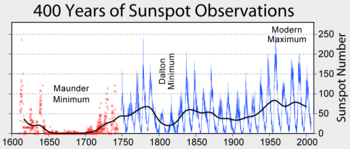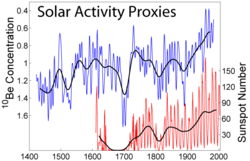Image:Solar-cycle-data.png
From Wikipedia, the free encyclopedia

Solar-cycle-data.png (700 × 466 pixel, file size: 44 KB, MIME type: image/png)
Description
This picture depicts the last three solar cycles as measured in solar irradiance, sunspot numbers, solar flare activity, and 10.7 cm radio flux. Solar irradiance, i.e the direct solar power at the top of the Earth's atmosphere, is depicted as both a daily measurement and a moving annual average. All other data are depicted as the annual average value.
The ~11 year solar magnetic cycle is a fundamental aspect of the sun's behaviour and is associated with variations in total output and activity. Irradiance measurements have only been available during the last three cycles and are based on a composite of many different observing satellites. However, the high correlation between irradiance measurements and other proxies of solar activity make it reasonable to estimate past solar activity. Most important among these proxies is the record of sunspot observations that has been recorded since ~1610. Since sunspots and associated faculae are directly responsible for small changes in the brightness of the sun, they are closely correlated to changes in solar output. Direct measurements of radio emissions from the sun also provide a proxy of solar activity that can be measured from the ground since such solar radiation is not substantially affected by the atmosphere. Lastly, solar flares are a type of solar activity that can impact life on Earth by affecting electrical systems, especially satellites. Flares only occur in the presence of sunspots, and hence the two are correlated, but flares are not directly tied to total solar luminosity.
Recently, it appears that solar irradiance is varying in ways that aren't duplicated by changes in sunspot observations or radio emissions. However, this conclusion is disputed. Some believe that shifts in irradiance may be the result of calibration problems in the measuring satellites. These speculations also admit the possibility that a small long term trend might exist in solar irradiance, though the data chosen for this plot do not have a significant trend. Also, the differences in flare activity over the three cycles would not be related to possible measurement artifacts in irradiance.
With respect to global warming, though solar activity has been at relatively high levels during the recent period, the fact that solar activity has been near constant during the last 30 years precludes solar variability from playing a large role in recent warming. It is estimated that the resdiual effects of the prolonged high solar activity account for between 18 and 36% of warming from 1950 to 1999.
Copyright
This image was created by Robert A. Rohde from the published data listed below and replaces an image created by William M. Connolley. It is part of the Global Warming Art project.
This image is an original work created for Global Warming Art.
Permission is granted to copy, distribute and/or modify this image under either:
- The GNU Free Documentation License Version 1.2; with no Invariant Sections, Front-Cover Texts, or Back-Cover Texts.
- The Creative Commons Attribution-NonCommercial-ShareAlike License Version 2.5
Please refer to the image description page on Global Warming Art for more information
- http://www.globalwarmingart.com/wiki/Image:Solar_Cycle_Variations.png
Data sources
- Irradiance: http://www.pmodwrc.ch/pmod.php?topic=tsi/composite/SolarConstant
- International sunspot number: http://www.ngdc.noaa.gov/stp/SOLAR/ftpsunspotnumber.html
- Flare index: http://www.koeri.boun.edu.tr/astronomy/readme.html
- 10.7cm radio flux: http://www.drao-ofr.hia-iha.nrc-cnrc.gc.ca/icarus/www/sol_home.shtml
References
- ^ Richard C. Willson, Alexander V. Mordvinov (2003). "Secular total solar irradiance trend during solar cycles 21–23". Geophysical Research Letters 30 (5): 1199.
- ^ Steven DeWitte, Dominiqu Crommelynck, Sabri Mekaoui, and Alexandre Joukoff (2004). "MEASUREMENT AND UNCERTAINTY OF THE LONG-TERM TOTAL SOLAR IRRADIANCE TREND". Solar Physics 224: 209–216.
- ^ Fröhlich, C. and J. Lean (2004). "Solar Radiative Output and its Variability: Evidence and Mechanisms". Astronomy and Astrophysical Reviews 12: 273-320.
- ^ Stott, Peter A.; Gareth S. Jones and John F. B. Mitchell (15 December 2003). " Do Models Underestimate the Solar Contribution to Recent Climate Change". Journal of Climate 16: 4079-4093. Retrieved on October 5, 2005.
File history
Legend: (cur) = this is the current file, (del) = delete this old version, (rev) = revert to this old version.
Click on date to download the file or see the image uploaded on that date.
- (del) (cur) 01:35, 15 July 2006 . . Dragons flight ( Talk | contribs) . . 700×466 (44,890 bytes) ({{GWArt}})
- (del) (rev) 21:46, 11 October 2004 . . William M. Connolley ( Talk | contribs) . . 753×565 (9,674 bytes) (Pic of 20 years of solar output data)
-
Edit this file using an external application
See the setup instructions for more information.
File links
- Global warming controversy
- Sun
- Solar cycle
- Solar variation
- User:Dragons flight/Images
Category: Global Warming Art images

